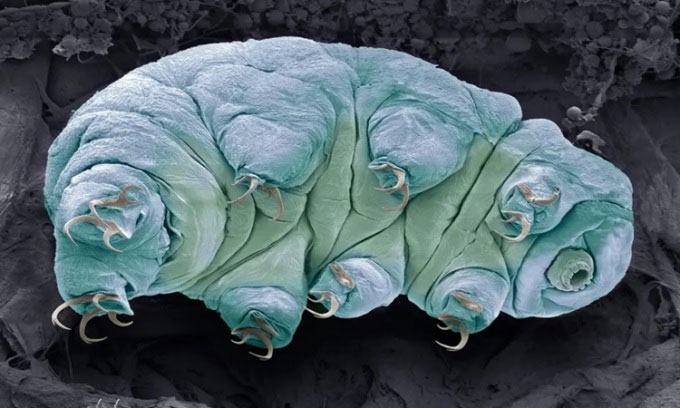The secret to helping tardigrades resist radiation
Researchers found that tardigrades have the ability to repair DNA damaged by gamma radiation or X-rays .
Molecular biologist Dr. De Cian and his colleagues shined gamma rays on the tardigrades. That beam is hundreds of times more powerful than the radiation needed to kill a human. However, the water bear survived, continuing to act as if nothing had happened. Scientists have long known that tardigrades are resistant to radiation , but only now have De Cian and other researchers discovered the secret behind their vitality. They discovered that tardigrades are masters of molecular repair, able to quickly reassemble broken pieces of DNA, according to two studies published in January on eLife and on April 12 in the journal Current Biology .

Water bears observed under a color scanning electron microscope. (Photo: Steve Gschmeissner/Science Photo Library).
Scientists have sought to destroy the tardigrade's ability to defend itself for centuries. In 1776, Lazzaro Spallanzani, an Italian naturalist, described water bears that could dry out completely, then regenerate when sprinkled with water. Over the next several decades, researchers found that tardigrades could endure extreme pressure, deep freeze, and even journey into space.
In 1963, a group of French researchers found that tardigrades could withstand strong X-rays. In more recent research, some types of tardigrades can be subjected to radiation doses up to 1,400 times higher than needed to kill humans. Radiation is dangerous because it breaks DNA chains. High-energy rays hitting DNA molecules can cause direct damage. It also causes harm by hitting other molecules inside cells. That altered molecule can attack the DNA.
Scientists suspect tardigrades can prevent or erase this damage. In 2016, a team at the University of Tokyo discovered that a protein called Dsup appears to protect tardigrade genes from high-energy rays and molecular alterations. They tested the hypothesis by placing Dsup in human cells and shooting X-rays at them. Cells with Dsup were less damaged than cells without the tardigrade protein.
That research got De Cian interested in tardigrades. She and her colleagues studied tardigrades collected from home gardens in Paris, along with one species from England and another from Antarctica. According to research results, gamma rays destroy tardigrade DNA but do not kill them. In another independent study, Courtney Clark-Hachtel, a biologist at the University of North Carolina at Asheville, and colleagues found that tardigrades have disrupted genes.
These findings suggest that the Dsup protein itself does not prevent DNA damage, although it may provide some protection. It's difficult to know for sure because scientists are still figuring out how to conduct experiments with tardigrades. For example, they couldn't modify them without the Dsup gene to see how they handled radiation.
Both new studies reveal another secret of tardigrades. They will quickly repair broken DNA. After tardigrades are exposed to radiation, their cells use hundreds of genes to create new proteins. Many of these genes are familiar to biologists, because other species, including humans, use them to repair damaged DNA. Human cells continuously repair genes. The DNA strands in a normal human cell break about 40 times a day, and each time, the cell repairs them. Water bears produce repair cells in surprisingly large quantities.
De Cian's team found that radiation also causes tardigrades to produce certain proteins never before seen in other animals . Currently, their function remains almost a mystery. Scientists chose TRD1, a particularly abundant protein , to study. When added to human cells, it appears to help the cells withstand DNA damage. Concordet speculates that TRD1 may bind to chromosomes and keep them in the correct shape, even when the DNA strands begin to deteriorate.
Research into proteins like TRD1 not only reveals the superpowers of tardigrades, but could also lead to new ideas for treating many diseases. DNA damage plays a large role in many types of cancer.
- If we want to live on Mars, why do humans need to breed with creatures that have existed on Earth for 530 million years?
- How dangerous is radiation?
- Video: Learn about the two types of radiation that surrounds us
- Radiation is deadly in the Martian mission
- How to limit radiation when sitting on a computer
- Use cosmic background radiation to encrypt data
- Diving, anti-radiation underwear
- People withstand radiation on Mars
- We are exposed daily to these radioactive sources
- Low-dose radiation is good for health?
- Decode the formation of SO2 gas on Venus's atmosphere
- Paint nano: Challenging harsh sea environment
 'Fine laughs' - Scary and painful torture in ancient times
'Fine laughs' - Scary and painful torture in ancient times The sequence of numbers 142857 of the Egyptian pyramids is known as the strangest number in the world - Why?
The sequence of numbers 142857 of the Egyptian pyramids is known as the strangest number in the world - Why? History of the iron
History of the iron What is alum?
What is alum?